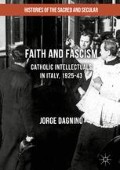Abstract
The departure of Montini in 1933 was a severe blow for many in the association. Unquestionably, the FUCI in the post-Montini-Righetti era came under closer scrutiny by the Italian hierarchy and adopted warmer attitudes to the Fascist government, leaving behind the cautious a-fascism of the previous administration; that is, the attitude of trying to refrain as much as possible from the political vicissitudes of the day. Righetti would still remain in the presidency of the organisation for the remainder of 1933 and part of 1934. However, he would face ever-growing pressures from other branches of Catholic Action and the hierarchy that had traditionally viewed with suspicion the activities of the association. Undoubtedly, the federation—in more respect than one—was in crisis, its very essence and mission being called into question. Significantly, this situation derived not from burgeoning conflicts with the regime and its youth organisations, but from within the Catholic camp itself. According to Renato Moro, what was at stake were differing and opposing conceptions of the nature and goals of Catholic Action and of its intended presence in Italian society. On the one hand, Righetti, Costa, and other exponents of the Montinian line espoused the patient and slow work of the religious and cultural formation of an elite, withdrawing as much as possible from the political vicissitudes of the day, whereas the vast majority of the national hierarchy supported the notion of a mass presence of the Catholic laity in search of immediate political success.1 In the post-1931 climate of increasingly close relations of Catholic associations with the Fascist government, the role of the FUCI as a centre of religious formation for the university students was considered by many problematic and even superfluous. Some, like the Cardinal Archbishop of Milan, Ildefonso Schuster, seemed to prefer direct religious support for Fascist university students through the chaplains of the Fascist university groups, the GUF, rather than—as had been traditional—through the FUCI. A bitter and disconsolate Milanese fucino wrote to Righetti in March 1934:
Access this chapter
Tax calculation will be finalised at checkout
Purchases are for personal use only
Author information
Authors and Affiliations
Copyright information
© 2017 The Author(s)
About this chapter
Cite this chapter
Dagnino, J. (2017). A Path to Modernity: The Fuci in the 1930s. In: Faith and Fascism. Histories of the Sacred and Secular, 1700-2000. Palgrave Macmillan, London. https://doi.org/10.1057/978-1-137-44894-1_5
Download citation
DOI: https://doi.org/10.1057/978-1-137-44894-1_5
Published:
Publisher Name: Palgrave Macmillan, London
Print ISBN: 978-1-137-44893-4
Online ISBN: 978-1-137-44894-1
eBook Packages: HistoryHistory (R0)

